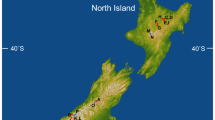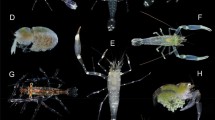Abstract
A protein electrophoretic survey of mytilids inhabiting deep-sea hydrothermal vents and cold-water methane/sulfide seeps revealed electromorph patterns diagnostic of 10 distinct species. From hydrothermal vents located at sites on the Galápagos Rift, the Mid-Atlantic Ridge, and the Mariana Back Arc Basin, we detected four species of mytilids. Six additional species were detected from three cold-water seep sides in the Gulf of Mexico. The patchy distribution and temporal stability of seeps may provide a greater opportunity for mytilid diversification and persistence than vent sites Nei's genetic distances (D) between species were relatively large (range: 0.528 to ∞) both within and among habitat types. This pronounced degree of genetic differentiation suggests a relatively ancient common ancestor for the group. Phylogenetic trees were generated using distance Wagner and parsimony analyses of allozyme and morphological characters. The tree topologies obtained from both methods support: (1) the hypothesis that a seep ancestor gave rise to the deep-sea hydrothermal vent mytilids, (2) a historical progression from shallow-water to deep-water habitats, and (3) a co-evolutionary progression from external to internal localization of bacterial symbionts. Whether the seep mytilid taxa constitute paraphyletic or polyphyletic groups remains unresolved. Our phylogenetic hypotheses also provide a benchmark for the phylogeny of mytilid bacterial symbionts.
Similar content being viewed by others
References
Baker HG (1965) Characteristics and modes of origin of weeds. In: Baker HG, Stebbins GL (eds) Genetics of colonizing species. Academic Press, New York, pp 147–172
Barrett M, Donoghue MJ, Sober E (1991) Against consensus. Syst Zool 40:486–493
Bougault H, Charlou JL, Fouquet Y, Needham HD, Vaslet N, Appriou P, Batiste PJ, Rona PA, Dmitriev L, Silantiev D (1993) Fast and slow spreading ridges: structure and hydrothermal activity, ultramafic topographic highs, and CH4 output. J geophys Res 98:9643–9651
Brooks JM, Kennicutt II MC, Bidigare RR, Fay RR (1985) Hydrates, oil seepage and chemosynthetic ecosystems on the Gulf of Mexico slope. Eos Trans, Am geophys Un 66: p 105
Brooks JM, Kennicutt II MC, Bidigare RR, Wade TL, Powell E, Denoux GJ, Fay RR, Childress JJ, Fisher CR, Rosman I, Boland G (1987) Hydrates, oil seepage, and chemosynthetic ecosystems on the Gulf of Mexico slope: An update. Eos Trans, Am geophys Un 68:498–499
Brooks JM, Wiesenburg DA, Roberts H, Carney RS, MacDonald IR, Fisher CR, Guinasso Jr NL, Sager WW, McDonald SJ, Burke Jr RA (1990) Salt, seeps, and symbiosis in the Gulf of Mexico. Eos Trans, Am geophys Un 71:1772–1773
Butterfield DA, Massoth GJ, McDuff RE, Lupton JE, Lilley MD (1990) The chemistry of phase separated hydrothermal fluids from axial seamount hydrothermal emissions study (ASHES) vent field, Juan de Fuca Ridge: subseafloor boiling and subsequent fluid-rock interaction. J geophys Res 95:12895–12921
Campbell AC, Palmer MR, Klinkhammer GP, Bowers TS, Edmond JM, Lawrence JR, Casey JF, Thompson G, Humphris S, Rona P, Karson J (1988) Chemistry of hot springs on the Mid-Atlantic Ridge. Nature, Lond 335:514–519
Cavalli-Sforza LL, Edwards AWF (1967) Phylogenetic analysis: models and estimation procedures. Am J hum Genet 19:233–257
Cavanaugh CM, Levering PR, Maki JS, Mitchell R, Lidstrom ME (1987) Symbiosis of methylotrophic bacteria and deep-sea mussels. Nature, Lond 325:346–348
Distel DL, Lane DJ, Olsen GJ, Giovannoni SJ, Pace B, Pace NR, Stahl DA, Felbeck H (1988) Sulfur-oxidizing bacterial endosymbionts: analysis of phylogeny and specificity by 16s rRNA sequences. J Bact 170:2506–2510
Fink WL (1982) The conceptual relationship between ontogeny and phylogeny. Paleobiology 8:254–264
Fisher CR (1990) Chemoautotrophic and methanotrophic symbioses in marine invertebrates. Rev aquat Sciences 2(3/4):399–436
Fisher CR (1993) Oxidation of methane by deep-sea mytilids in the Gulf of Mexico. In: Oremland RS (ed) Biogeochemistry of global change: radiatively active trace gases. Chapman & Hall, London, pp 606–619
Fustec A, Desbruyeres D, Juniper SK (1987) Deep-sea hydrothermal vent communities at 13°N on the East Pacific Rise: microdistribution and temporal variations. Biol Oceanogr 4:121–164
Gaffney PM, Scott TM, Koehn RF, Diehl WJ (1990) Interrelationships of heterozygosity, growth rate and heterozygote deficiencies in the coot clam, Mulinia lateralis. Genetics, Austin, Tex 124:687–699
Grassle JF (1986a) Animals at Mid-Atlantic Ridge hydrothermal vents. Eos Trans, Am geophys Un 67:p 1100
Grassle JF (1986b) The ecology of deep-sea hydrothermal vent communities. Adv mar Biol 23:301–362
Grassle JP (1985) Genetic differentiation in populations of hydrothermal vent mussels (Bathymodiolus tehrmophilus) from the Galapagos Rift and 13°N on the East Pacific Rise. Bull biol Soc Wash 6:429–442
Hecker B (1985) Fauna from a cold sulfur seep in the Gulf of Mexico: comparison with hydrothermal vent communities and evolutionary implications. Bull biol Soc Wash 6:465–474
Hessler RR, Lonsdale PF (1991) Biogeography of Mariana trough hydrothermal vent communities. Deep-Sea Res 38:185–199
Hessler R, Lonsdale P, Hawkins J (1988a) Patterns on the ocean floor. New Scient 24:47–51
Hessler RR, Smithey WM, Boudrias MA, Keller CH, Lutz RA, Childress JJ (1988b) Temporal change in megafauna at the Rose Garden hydrothermal vent (Galapagos Rift; eastern tropical Pacific). Deep-Sea Res 35:1681–1709
Jannasch HW (1989) Chemosynthetically sustained ecosystems in the deep sea. In: Schlegel HG, Bowien B (eds) Autotrophic bacteria. Science Tech Publishers, and Springer-Verlag, Madison and Berlin, pp 147–166
Jones TR, Kluge AG, Wolf AJ (1993) When theories and methodologies clash: a phylogenetic reanalysis of the North American ambystomatid salamanders (Caudata: Ambystomatidae). Syst Biol 42:92–102
Kennicutt II MC, Brooks JM, Bidigare RR, Denoux GJ (1988) Gulf of Mexico hydrocarbon seep communities. I. Regional distribution of hydrocarbon seepage and associated fauna. Deep-Sea Res 35:1639–1651
Kennicutt II MC, Brooks JM, Bidigare RR, Fay RR, Wade TL, Mcdonald TJ (1985) Vent-type taxa in a hydrocarbon seep region on the Louisiana Slope. Nature, Lond 317:351–353
Kluge AG (1989) A concern for evidence and a phylogenetic hypothesis of relationships among Epicrates (Boidae, Serpentes) Syst Zool 38:7–25
Lalou C, Brichet E (1982) Ages and implications of East Pacific Rise sulphide deposits at 21°N. Nature, Lond 300:169–171
Lalou C, Reyss JL, Brichet E, Arnold M, Thompson G, Fouquet Y, Rona PA (1993) New age data for Mid-Atlantic Ridge hydrothermal sites: TAG and Snakepit chronology revisited. J geophys Res 98:9705–9713
MacDonald IR, Boland GS, Baker JS, Brooks JM, Kennicutt II MC, Bidigare RR (1989) Gulf of Mexico hydrocarbon seep communities. II. Spatial distribution of seep organisms and hydrocarbons at Bush Hill. Mar Biol 101:235–247
MacDonald IR, Callender WR, Burke Jr RA, McDonald SJ, Carney RS (1990a) Fine-scale distribution of methanotrophic mussels at a Louisiana cold seep. Prog Oceanogr 24:15–24
MacDonald IR, Guinasso Jr NL, Reilly II JF, Brooks JM, Callender WR, Gabrielle SG (1990b) Gulf of Mexico hydrocarbon seep communities: VI patterns in community structure and habitat. Geo-mar Lett 10:244–252
MacDonald IR, Reilly II JF, Guinasso Jr NL, Brooks JM, Carney RS, Bryant WA, Bright TJ (1990c) Chemosynthetic mussels at a brine-filled pockmark in the northern Gulf of Mexico. Science, NY 248:1096–1099
Macdonald KC (1982) Mid-ocean ridges: fine scale tectonic volcanic and hydrothermal processes within the plate boundary zone. A Rev Earth planet Sciences 10:155–190
Macdonald KC, Fox PJ, Perram LJ, Eisen MF, Haymon RM, Miller SP, Carbotte SM, Cormier M-H, Shor AN (1988) A new view of the mid-ocean ridge from the behaviour of ridge-axis discontinuities. Nature, Lond 335:217–225
Maddison WP, Maddison DR (1992) MacClade. Sinauer Associates, Inc., Sunderland, Massachusetts
McLean JH (1985) Preliminary report on the limpets at hydrothermal vents. Bull biol Soc Wash 6:159–166
Mulvey M, Vrijenhoek RC (1982) Population structure in Biomphalaria glabrata: examination of an hypothesis for the patchy distribution of susceptibility to schistosomiasis. Am J trop Med Hyg 31:1195–1200
Murphy RW, Sites Jr JW, Buth DG, Houfler CH (1990) Proteins I: Isozyme electrophoresis. In: Hillis D, Moritz C (eds) Molecular systematics. Sinauer Assoc. Inc., Sunderland, Massachusetts, pp 45–126
Needham HD, Carre D (1990) Transit PABRE. Oceanol Acta (Spec Vol) 10:343–347
Needham HD, Francheteau J (1974) Some characteristics of the rift valley in the Atlantic Ocean near 36°48′N. Earth planet Sci Lett 22:29–43
Nei M (1978) Estimation of average heterozygosity and genetic distance from a small number of individuals. Genetics, Austin, Tex 89:583–590
Nei M (1987) Molecular evolutionary genetics. Columbia University Press, New York
Newman WA (1985) The abyssal hydrothermal vent invertebrate fauna, a glimpse of antiquity? Bull biol Soc Wash 6:231–242
Paull CK, Hecker B, Commeau R, Freeman-Lynde RP, Neumann C, Corso WP, Golubic S, Hook JE, Sikes E, Curray J (1984) Biological communities at the Florida escarpment resemble hydrothermal vent taxa. Science, NY 226:965–967
Richter-Bernburg G (1987) Deformation within salt bodies. In: Lerche I, O'Brien JJ (eds) Dynamical geology of salt and related structures. Academic Press, Inc., Orlando, Florida, pp 39–75
Sempere J-C, Purdy GM, Schouten H (1990) Segmentation of the Mid-Atlantic Ridge between 24°N and 30°40′N. Nature, Lond 344:427–431
Skibinski DOF, Beardmore JA, Cross TF (1983) Aspects of the population genetics of Mytilus (Mytilidae; Mollusca) in the British Isles. Biol J Linn Soc 19:137–183
Skibinski DOF, Cross TF, Ahmad M (1980) Electrophoretic investigation of systematic relationships in the marine mussels Modiolus modiolus L., Mytilus edulis L., and Mytilus galloprovincialis Lmk. (Mytilidae; Mollusca). Biol J Linn Soc 13:65, 73137/183
Swofford DL (1990) PAUP: Phylogenetic analysis using parsimony, Version 3.0. Illinois Natural History Survey, Champaign, Illinois
Swofford DL, Selander RK (1981) BIOSYS-1: a Fortran program for the comprehensive analysis of electrophoretic data in population genetics and systematics. J Hered 72:281–283
Thompson G, Humphris SE, Schroeder B, Sulanowska M, Rona PA (1988) Active vents and massive sulfides at 26°N (TAG) and 23°N (Snakepit) on the Mid-Atlantic Ridge. Can Mineralogist 26:697–711
Tunnicliffe V (1991) The biology of hydrothermal vents: ecology and evolution. Oceanogr mar Biol A Rev 29:319–407
Tunnicliffe V, Juniper SK (1990) Dynamic character of the hydrothermal vent habitat and the nature of sulphide chimney fauna. Prog Oceanogr 24:1–13
Van Dover CL (1990) Biogeography of hydrothermal vent communities along seafloor spreading centers. Trends Ecol Evol 5:238–243
Author information
Authors and Affiliations
Additional information
Communicated by N. H. Marcus, Tallahassee
Rights and permissions
About this article
Cite this article
Craddock, C., Hoeh, W.R., Gustafson, R.G. et al. Evolutionary relationships among deep-sea mytilids (Bivalvia: Mytilidae) from hydrothermal vents and cold-water methane/sulfide seeps. Marine Biology 121, 477–485 (1995). https://doi.org/10.1007/BF00349456
Received:
Accepted:
Issue Date:
DOI: https://doi.org/10.1007/BF00349456




